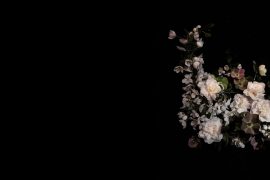Daren Redman is a textile artist who specializes in making quilts. Make no mistake though – these aren’t your grandmother’s quilts! PATTERN recently sat down with Redman to discuss her take on quilting, her installation at the Grand Canyon, and her creative process.
Allie Coppedge: You went to school for dental lab technology studies and public relations, so how did you end up as a textile artist?
Daren Redman: After getting degrees in public relations and dental lab, I was the student intern at Oak Ridge National Lab in the public affairs office. Oakridge is where I met Dave Redman, my husband. There was a hiring freeze at the time, so Dave asked why don’t I move to Indianapolis and look for a job there. I couldn’t find anything, so I started working at Jacobson’s. After working there for some time, Dave retired and I also left my job. I then had to find ways to occupy my time. My mom had given me her grandmother’s quilt top, so I took it to the Brown County Historical Society where they sew, spin, and weave. I ended up joining and then they taught me how to quilt. Later, Dave and I traveled to Santa Fe and saw a wall hanging by Nancy Crow. It was quilted but still modern. I saw that she was giving lessons on designing quilts and developing your own style and voice. I took those workshops and a few dyeing classes as well. It started as a hobby, but then I saw there were all of these shows out there. I started entering them just to see if I could get in. I got in and also gained clients! Everything spiraled from there.
AC: Were the Nancy Crow workshops your only formal training?
DR: Yes. Her classes consisted of assigning a piece at 10 a.m. The quilt top would need to be done by 4 p.m. that same day. I would then take those pieces home and sew them together. By the end I had about five quilts in three weeks. A couple of those have sold, and a couple are also up in Fort Wayne on display right now. She made you create, compose, and finish the work. Very inspirational.
My mom had given me her grandmother’s quilt top, so I took it to the Brown County Historical Society where they sew, spin, and weave. I ended up joining and then they taught me how to quilt.
AC: You did an art installation at the North Rim of the Grand Canyon. What was that like and what did you accomplish during your time there?
DR: I’m a big planner, so I planned about a year out. I needed inspiration to dye fabrics. I decided to use silk because it’s very light, easy to ship, and easy to dye in large quantities. I also hiked the North Rim for two nights. I proportioned all of the fabric and dyes ahead of time and only took a couple of measuring cups and shoeboxes along. I decided to take colors that represented the Rim’s geology. There are 14 layers of geology. All of the colors represent different years. For example, the top layer is 250 million years old. I would hike to a layer, take a million photos, camp, and repeat. Then I set up a little dye station outside the cabin. I devoted a certain amount of time to each layer and then dye 30 feet of fabric that one color.
AC: What did the finished piece look like?
DR: There were a total of seven installations along the North Rim. I was at 8,000 feet above sea level, whereas Brown County is about 800 feet. One was purple and draped on a 30 foot long fallen log. I also had one made of 14 colors that represented the grand canyon that hung from a tree.
AC: You were talking about dyeing your own fabrics, and I saw on your website you said that you are currently using the traditional Japanese dye techniques arashi and itajime shibori. What are these techniques and what makes them different from traditional dyeing?
DR: Arashi Shibori is where you take fabric and wrap it around a round pole, put string around it, and dip the fabric in dye. The string resists the dye on the fabric, so you end up with all of these stripes.
Itajime means clamp and resist. I take two pieces of wood, accordion fold fabric, and fold it up compactly. The two clamps go on top of that. Wherever the clamps are, that’s where the resist is. When you open up this little origami piece of fabric, there’s all of these patterns, which are usually geometric. It’s like tie dye.

AC: How did you learn those techniques?
DR: I flew to Minnesota to take a class from a professor from the University of Buffalo.
AC: What’s your ideal workspace?
DR: I don’t listen to the music or TV; it’s all silence and solitude. I made that decision 10 years ago to work that way. So if I open the door of my studio, I just hear birds. It’s really nice.
AC: How do you promote and sell your work?
DR: When I enter a quilt show, the piece gets in the show about 98 percent of the time. My husband is a photographer, so he then takes photos of them to be featured in magazines. WTIU filmed me for their weekly special too. I’m an Indiana artisan and propose for different grants in Indy, so people know me from that. It’s online and in the news when I get those grants.
AC: What’s next for you?
DR: I have a show at the Madame Walker Theatre in October. I also want to enter a show by Studio Art Quilt Association, which is an international show. It’s called Season After Season. The quilts each represent one season. I also have another quilt I’ve proposed for a public art project, which hasn’t been announced yet Finally, I have a quilt that’s going to Houston in November. Textile posters is the theme.
Visit Daren’s website to learn more about her work.



